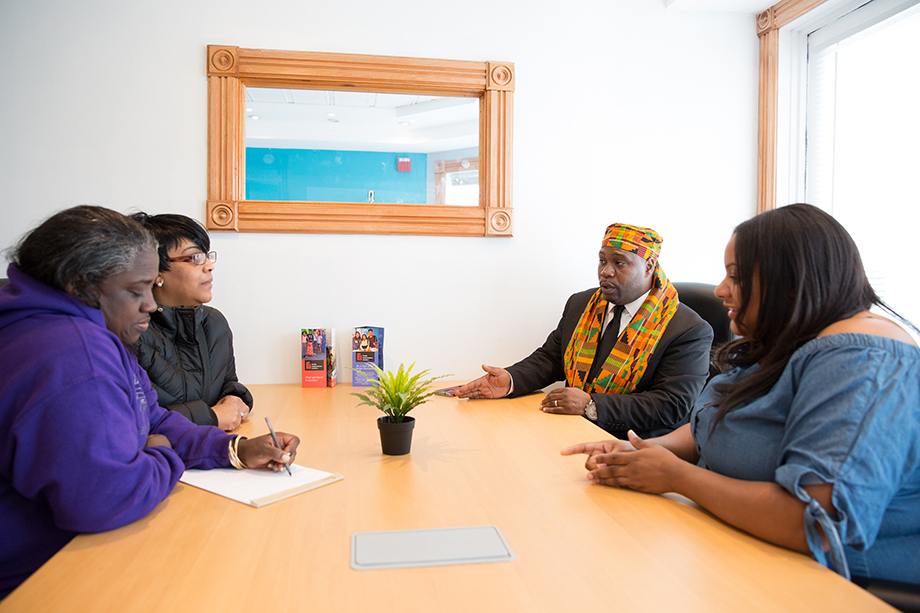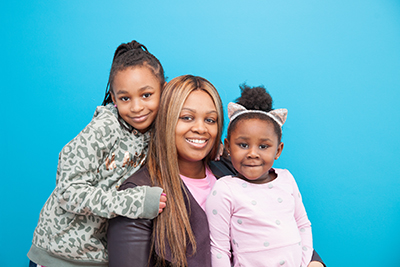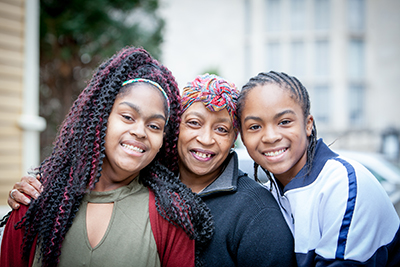Community
Location: Greater Boston, Massachusetts
Sample individual goals for FII peer groups:
- Earn a degree
- Increase income
- Reduce credit card debt
- Obtain a driver's license
Information shared through FII peer groups:
- Computer skills training programs for adults
- App for tracking/improving credit scores
- Housing resources
- After-school programs for children
Community Context
The city of Boston and its surrounding metropolitan area, with its blue chip colleges and universities, is widely regarded as one of the world’s leading talent factories and an innovation hotbed that’s produced thousands of startups, some valued at more than $1 billion. A bastion of progressive idealism, the city’s households are at or near the top of six areas of charitable giving in the United States, including health, education, and human services.
Unfortunately, Boston also tops an exceptionally unenviable list that conveys the prejudice and economic challenges some residents experience. In a national survey commissioned by The Boston Globe, Black respondents ranked Boston as the least welcoming to people of color out of eight major cities. Black Americans in Greater Boston had a median net worth of just eight dollars (meaning they owed almost as much as they owned), according to a 2015 report from the Federal Reserve Bank of Boston, and Census Bureau data show that Black unemployment in Greater Boston was double the rate of white workers in 2018, before the inequitable impact of COVID-19 on unemployment. Latinx encounter similar economic obstacles: although they represent 92 percent of Boston’s population growth over the past few decades, they earn just 48 cents on the dollar compared to white households.
However, amid that dispiriting reality, there are glimmers of progress. In neighborhoods across Greater Boston, low-income individuals and families, most of whom are people of color, are meeting in small groups, identifying life-enhancing goals, and sharing ideas for surmounting racial barriers and achieving upward economic mobility. Individuals within these peer groups earn a no-strings-attached, cash stipend and access to resources from a nonprofit, Family Independence Initiative (FII). A crucial part of FII’s model is that the peers themselves take on the task of leading their own change.

Thanks in part to her peer group, Marlene Sulvane Williams, who was born in Haiti and now lives in Cambridge (just across the Charles River from Boston), has launched her own small business, supporting the parents of very young children. Crystal Murphy, from Boston’s Hyde Park neighborhood, completed her schooling and landed a position with Boston Public Schools, her first full-time job with a salary and benefits. Today, she works as a family liaison for FII-Boston. Debbie Bonillo, also from Cambridge, made significant progress toward improving her credit score and chipping away at her mortgage.
Those are individual accomplishments, but they grew out of peer power, where small groups of people exchange ideas, celebrate breakthroughs, and lift one another up when the world sets them back. Participants shared that this mutually supportive, self-directed approach marked a sea-change difference from the top-down, prescriptive social programs they had also experienced. “We’re more independent,” said Williams. “We’re taking control of what we want for ourselves.”
Peer-Driven Change: Origins & Evolution
As Bridgespan reported in a Stanford Social Innovation Review article, the social entrepreneur Mauricio Miller began to showcase the potential of peer-driven change in the United States, when he founded FII in 2001. Drawing from his experiences growing up among the working poor in San Jose, California, Miller developed FII as an alternative approach to poverty alleviation, by elevating the strengths of people experiencing poverty instead of focusing on their supposed weaknesses. (In 2019, he launched the Community Independence Initiative, to expand the model to countries including Liberia, Colombia, Mexico, and the Philippines.)
By giving participants the space to opt into initiatives of their own choosing and the latitude to set their own direction and make their own choices, FII taps into one of peer-driven change’s key features: initiative and self-determination. The opt-in approach, supported by abundant scientific research on human motivation, is based on the notion that when people have sufficient autonomy to direct their own change, they often achieve better outcomes.
FII facilitates an environment where low-income individuals can collaborate with their peers, but it is the peers themselves who identify their personal goals—such as completing their education, raising their income, or reducing their credit card debt—and support one another as they work to build durable pathways to prosperity. This reflects the second feature of peer-driven change: mutuality, the feedstock of collective empowerment.
FII also provides the approach's third feature, financial capital, by investing an average of $2,400 in households over a two-year period. To access these unrestricted dollars, families commit to tracking their self-identified goals and how they accomplished them in online journals. They are also encouraged to meet with their peers in small groups each month to facilitate their own discussions and support one another.
In 2010, FII expanded from its home base in the Bay Area to Greater Boston. As the first sets of peers tapped into their relationships and networks to help each other out—and demonstrated that trust and mutuality increase the odds that peers might collectively climb the income ladder—word of FII’s approach slowly began to spread across neighborhoods. Individuals sought out FII because someone in their social network attested to the benefits of peers supporting peers; the unconditional cash stipend and access to resources were also enticing. Thus far, FII’s Greater Boston branch has served roughly 3,100 individuals and 1,000 families.
Differences in geographic and racial identity do not seem to impede the sense of community among FII’s Greater Boston peers. A Bridgespan research team saw examples of strong connections across geographically distant individuals (such as from the Mattapan neighborhood at the southern end of Boston and the city of Cambridge, just north of Boston) and among an array of races and ethnicities, including Puerto Rican, Haitian, and African-American.
“I was the only African-American in my group,” recalled Crystal Murphy. “Others were Puerto Rican or Dominican. There can be mistrust among people who don’t know each other—not wanting to share what it is they are going through. But once families get a chance to meet, all those concerns go away. You’re meeting other like-minded people that you can grow with and learn from.”

Peer-Driven Change’s Inner Workings
FII strives to form groups of about six to eight people, often comprised of individuals sharing an affinity network (friends, neighbors, work colleagues, church members)—although peer groups can include people who have never met previously. Creating enough comfort for participants to reveal very personal challenges—as well as sufficient trust that peers are willing and able to help—takes time. One participant recalled that her group spent its first three meetings “staring at each other and eating pizza.” To cement the expectation that it’s up to the group to pull together and work collectively to solve their challenges, FII staffers are trained to not intervene and offer solutions.
Establishing a cohesive group dynamic is not a sure thing. Sometimes, people fail to connect and the group disbands. Crystal Murphy’s group only began to click when it adopted a “workshop format,” where for each meeting, a different person was responsible for sharing resources, such as information on afterschool programs for children and computer-skills training for parents. In this way, peers learned about the Boston Housing Authority’s resources for subsidized housing and an app for tracking and improving their credit scores.
To take on a vexing challenge that seemed out of reach, peers broke it down into discrete, achievable steps. For example, to help a peer pump up an anemic credit score, the group first reviewed her finances, questioned the logic of opening a new line of credit, and then worked with her to develop a feasibility plan for making monthly payments. As she made incremental progress against these steps, she stood a better chance of summoning the initiative and determination to achieve her overriding goal.
When group members began to bond and felt confident enough to share their goals, positive peer pressure often emerged. One participant recalled that she wanted to purchase a place of her own. A Massachusetts First Time Home Buyer program was located next to her place of employment, but she had never taken advantage of it—until her peer group pushed her to enroll. Another participant recalled that when she returned to school, peers often texted her, to ensure she was on track to complete a major homework assignment. Peers held one another accountable for their commitments and even vied to be the first to complete their self-assigned tasks.
“It gets competitive, I’m not going to lie,” said Marlene Sulvane Williams. “You have to be prepared.”
Answering one simple question in FII’s online journal—“What actions have you taken toward your goals since last month?”—is another way for individuals (along with their peers) to hold themselves accountable. Journaling also gives peers a chance to momentarily step back from the demands of daily life and take stock. “Having the space to really reflect on your life and what you want for yourself, rather than someone telling you what you need to do, is very powerful,” observed Williams.
Among successful FII peer groups, there was a nourishing dynamic at play: along with peer pressure, there was also peer support, such as when peers celebrated a group member’s diligence in paying off a car loan. That kind of affirmation offered a two-sided advantage. With each achievement, individual peers gained a little more confidence to take on more. At the same time, there was a spillover effect on the larger group, as people experienced a greater sense of empowerment and agency to improve their own well-being. Each person’s change objectives were distinct, of course, but each accomplishment was a vital source of validation for the entire group.
In fact, participants underlined the compassion and understanding they drew from other group members. As one peer put it, “They really met me where I was.” That kind of empathy sustained individuals as they pursued a range of improvement goals that other social programs might have deemed idiosyncratic or insignificant, such as obtaining a driver’s license. “My team feels like my family at this point,” said Debbie Bonillo.
However, just because an FII peer group got off the ground, it didn’t always endure for the full two years. Because of life changes or having to shoulder new responsibilities, some members withdrew and their groups disbanded. Nevertheless, some peers continued to connect with others through texts and group chats, even after their group dispersed. These peer-to-peer knowledge exchanges, virtual as well as physical, empower people who are collectively forging home-grown solutions to their challenges.
Progress & Results
Over the course of their two-year enrollment period, the median monthly income of FII’s Greater Boston families increased from $1,500 to $1,800. Families also reported that monthly subsidies such as Temporary Assistance for Needy Families and the Supplemental Nutrition Assistance Program on average decreased from $91 per household to $47.

As families expanded their social networks, they reported a three-fold increase in social capital—that is, mutually beneficial, peer-to-peer exchanges of resources, information, and direct assistance, such as providing food or day care. Across families, new social connections were instrumental in helping peers obtain jobs, secure housing, learn of career development opportunities, acquire financial management skills, and understand the steps required to purchase property. For example, one participant recalled that a referral from her network helped her learn about, and eventually secure, her first full-time job, which she described as a crucial breakthrough in her life.
Some successes were not confined to a single goal, but instead spanned multiple aspects of peers’ lives. Another participant, after initially seeking to improve her housing situation, education, and employment (and successfully doing so), was emboldened to launch a small business. This and similar examples suggest that peer-driven progress has a compounding effect: when friends work together to improve their lives, confidence grows and they stretch to accomplish more.
Over time, some participants got more involved with their communities. Some families collected and distributed winter coats to the homeless; assembled backpacks and school supplies for area families, in preparation for the new school year; and organized Boston Connects, a social event open to all FII families throughout the Boston area, as well as the broader public.
Taken together, the enhanced social networks and sense of community contributed to a greater degree of civic engagement. Some FII families have spearheaded voter registration drives, launched efforts to increase awareness about election issues, and hosted community forums with politicians. By collectively empowering one another, peers acquired the confidence and the capacity to engage politically.
Key Insights
Information and reflection empower. FII’s cloud-based journaling system lets peers track their progress in real-time. When they enter changes in their income or credit score, they can chart those changes against the information they have entered previously. The instant feedback is another tool that helps peers exert greater control over their lives, since they make their own choices and they own the results—an especially important development for people who often feel disempowered by society.
Highly empowered, but also highly accountable. By reflecting on their goals and the paths they’ve chosen for improving their lives, participants are accountable not only to themselves, but also to their peer group. FII’s online dashboard lets participants track their progress against other peers’ anonymized outcomes, which feeds the instinct to do better. And of course, peers have publicly committed to their goals, which exposes them to positive peer pressure.
“You have to hold yourself accountable,” said Debbie Bonillo. “But you also have a team of people that every month, we’re meeting and saying where we’re at. So for me, I said, ‘I’m not slacking.’”
Philanthropy can help scale peer-driven change. Beyond supporting and expanding FII’s efforts across Greater Boston, funders are financing a three-year study evaluating the effects of increased access to social and financial capital on families’ economic mobility and well-being. The study is a partnership between FII, the City of Boston, and the Massachusetts Department of Transitional Assistance, the Commonwealth’s primary provider of economic and nutritional assistance programs for low-income families. After the three-year study is completed, the partners will have hard data to help advance the social services sector’s understanding of the types of outcomes families living with low-incomes achieve when they can access financial capital, as well as an environment that supports them in harnessing their social networks.
This case study was researched and written by Bridgespan partners Rohit Menezes and Willa Seldon, and Manager Simon Morfit, from the San Francisco office, along with Editorial Director Bill Breen, who works from Bridgespan’s Boston office. The authors thank former Bridgespan Consultant Rachel Heredia for her research and insights.

